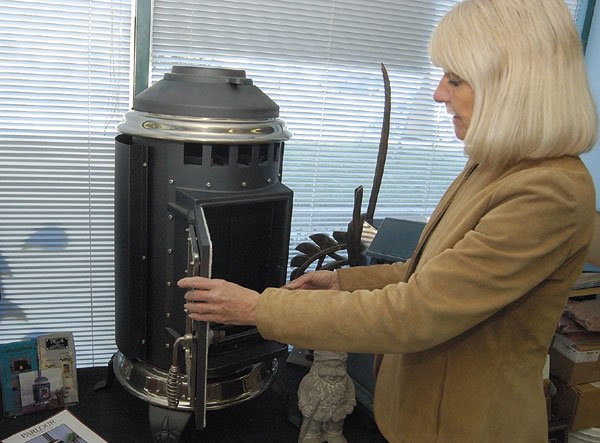Gilroy – Wood pellets used to power stoves have gone AWOL on the
West Coast, stranding homeowners who need the fuel for heat. As the
mercury drops, some residents have panicked, frantically phoning
hardware stores, clicking through Craigslist ads online, and
criss-crossing the county in search of the pellets.
Gilroy – Wood pellets used to power stoves have gone AWOL on the West Coast, stranding homeowners who need the fuel for heat. As the mercury drops, some residents have panicked, frantically phoning hardware stores, clicking through Craigslist ads online, and criss-crossing the county in search of the pellets.
“I’m on every waiting list from here to Los Banos,” said Sharon Petersen, who lives in an 80-year-old cabin south of San Jose. For the past month, she’s spent up to 15 hours a week searching stores and the Web for pellets, her sole source of heat. When they disappear, she said, “It creates quite a crisis!”
Pellet stoves have exploded in popularity over the past few years, as sky-high oil prices prod consumers toward alternative fuels. That’s pushed up demand for the pellets that power them. Last year, East Coast consumers felt the pinch, as manufacturers scrambled to supply them with pellets; this year, the frost-bitten West is facing shortages of the nouveau fuel. It’s the first shortage that Petersen can recall since she switched to pellet heat 11 years ago.
“We didn’t even sell pellet stoves until a few years ago,” said Cindy Wicklund, manager of Jack’s Pool Service and Stoves in Morgan Hill, “and now, they’re the majority of our sales.”
Pellets have emerged as an eco-friendly alternative to wood-burning stoves, which pollute the air with tiny particles that aggravate asthma. Researchers have linked such particles to lung cancer and heart disease, according to Michael Jerrett, associate professor of preventive medicine at the Keck School of Medicine of the University of Southern California.
In 2005, Gilroy restricted wood-burning stoves in new homes. Most developers have opted for gas fireplaces, said city environmental programs coordinator Lisa Jensema, but some owners have installed pellet stoves in older homes, attracted by low costs and lower emissions. Pellet stoves are 80 to 85 percent efficient, said Jensema: a 40-pound bag of pellets produces less than a cup of ashes. The Pellet Fuels Institute, a fuel manufacturers’ group, estimates that 800,000 homes nationwide use pellet heat.
“When the price of oil skyrocketed, everyone started switching over to pellet stoves,” said Tony Neumayer, marketing manager of Eureka Pellet Mills Inc., in Missoula, Mont. “The demand is unbelievable. We can’t keep up with it.”
As demand shot upwards, supplies declined. Housing construction has slowed, and that means mills are shedding less sawdust, which is compressed to produce the pellets. That adds up to a shortage, and a lot of frustrated customers. The phone is ringing off the hook at Orchard Supply Hardware’s Gilroy store, where manager Don McClellan says 30 people call a day, asking for pellets; Craigslist seller Merrick Browne got 20 calls in a day a half, after advertising bags of wood pellets. Even stove suppliers fend off requests. New messages appear on Wicklund’s answering machine every morning, she said, pleading for pellets.
“We don’t sell them,” Wicklund explained. “But people are just calling anywhere to try and get them, I guess.”
This week, Petersen nearly ran out of pellets before snapping up a ton from Browne, the eBay seller, a good Samaritan who hauled the fuel from out-of-state, and offered free delivery to Bay Area homes.
“Luckily, I hadn’t run out of pellets – but I was close,” said Petersen. Unsurprisingly, “installing a central heating system has suddenly moved up on my priority list.”
Shelves are empty at Ace Hardware and Home Depot, waiting on East Coast shipments. Orchard Supply Hardware keeps a waiting list, and rations the pellets, limiting customers to five bags each. When pellets do arrive, McClellan said, they disappear within the hour.
And prices have jumped. Four-dollar bags of pellets, which provide roughly 20 hours of heat, have doubled in price at area stores, and sell for even more online. Shipping pellets cross-country causes some mark-up, but some consumers suspect profiteering.
“People are selling them for $10 a bag – that’s criminal,” said Browne, who sold his cargo for $350 a ton. Petersen says two tons of pellets can keep her warm through the coldest California winter. In the past, that added up to $500; this year, she’s paying more than $700 to make it to spring.
Pellet manufacturers say there’s no cause for alarm.
“It’s just a blip,” said Don Kaiser, executive director of the Pellet Fuels Institute. “There’s pellets aplenty here in the East – we’ve had a very mild winter here. The tightness in California is a result of the weather, and it’s difficult to ship pellets across the country. The cost of freight is just exorbitant.”
But for those who depend on pellets for heat, it’s a price they’re willing to pay. Some homeowners are ordering pellets online from sawmills in the East and Midwest, markups and all. Others are having second thoughts about their pellet-powered stoves.
“I’m in the clear for this winter,” said Petersen, “but in the future, I need a back-up plan.”














